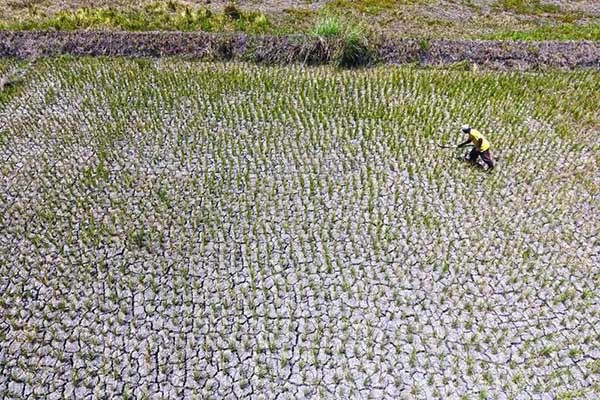El Niño destroys P8-B agri crops in 14 regions in the Philippines

NDRRMC executive director and Office of Civil Defense administrator Ricardo Jalad also said the drought has exacted a toll on at least 247,610 farmers. Walter Bollozos
MANILA, May 4, 2019, PhilStar. Agricultural damage across the country due to the prevailing dry spell or El Niño has reached almost P8 billion, the National Disaster Risk Reduction and Management Council (NDRRMC) reported yesterday, reported the Philippine Star.
NDRRMC executive director and Office of Civil Defense administrator Ricardo Jalad also said the drought has exacted a toll on at least 247,610 farmers.
“An estimated P7,962,521,866 in damage to agriculture was reported in the 14 regions,” Jalad said, adding that most of those damaged are rice and corn as well as high value crops.
As of yesterday, the drought has affected 34,602 hectares of farmlands in the Cordillera Administrative Region, affecting 27,449 farmers; 1,199 hectares in Ilocos region with 897 farmers affected; 125,732 hectares in Cagayan Valley, with 112,580 farmers affected; and 1,143 hectares in Central Luzon.
In Calabarzon (Cavite-Laguna-Batangas-Rizal-Quezon), 5,509 hectares have been affected by the drought, with 5,257 farmers losing their crops; Mimaropa (Mindoro-Marinduque-Romblon-Palawan) with 17,847 hectares of farmlands and 13,204 farmers affected; Bicol, with 26,676 hectares and 22,902 farmers affected; Western Visayas, with 3,254 hectares and 4,056 farmers affected; Eastern Visayas with 15,146 hectares of farmlands and 18,187 farmers affected.
Down south, 7,230 hectares of farmlands and 6,859 farmers were affected by the dry spell in Western Mindanao; 6,498 hectares and 5,085 farmers in Northern Mindanao; 1,557 hectares of farmlands and 1,843 farmers in Davao; 9,977 hectares and 8,655 farmers in Central Mindanao; 2,525 hectares and 2,213 farmers in Caraga; and 18,995 hectares of farmlands and 18,423 farmers affected in Bangsamoro Autonomous Region in Muslim Mindanao (BARRM).
“A total of 43 local government units (LGUs) have declared a state of calamity due to the dry spell,” the NDRRMC reported.
The LGUs that declared states of calamity include Paracelis, Mountain Province; Dupax del Norte, Nueva Vizcaya in Cagayan Valley; Quezon province in Calabarzon; San Jose and Rizal towns in Occidental Mindoro; and Sta. Cruz town in Marinduque in Mimaropa.
In the Bicol region, the province of Camarines Sur is now under a state calamity as well as the towns of Lambunao, Bingawan, Sta. Barbara, Janiuay, Maasin in Iloilo province and Murcia town in Negros Occidental in Western Visayas.
Cebu province is also under a state of calamity in Central Visayas as well as San Isidro, Leyte province in Eastern Visayas; Zamboanga City in Western Mindanao; Matanao in Davao region; Alamada, M’lang, Pikit, Aleosan, Magpet, Tulunan, Arakan, the entire Cotabato province including the towns of Matalam, Latuyan, Sultan Kudarat and Kidawapan City, Alabel, Sarangani, Bagumbayan, Sultan Kudarat, T’Boli, South Cotabato and the entire Sultan Kudarat province, all in Central Mindanao.
In the BARRM a state of calamity has been declared over wide areas of Maguindanao particularly over Paglat town, Sultan Kudarat, Matanog, Datu Abdullah Sanki, Pagalungan, Upi, Ampatuan and Wao in Lanao del Sur as well as the province of Basilan.
The Department of Agriculture (DA) issued Special Order No. 945 series of 2019 for the creation of the DA National El Niño Task Force to monitor and coordinate various El Niño programs with DA units and the NDRRMC.
Jalad said the DA has released a total of P18.3 million for cloud-seeding operations while continuous monitoring of water quantity and quality in vulnerable areas is being done.
Meanwhile, the Department of Health is focusing its efforts on the effects of the drought on the residents, including the provision of food supplements to address malnutrition as well as the issuance of information, campaigns and advisories.
“Hospitals and health facilities have been alerted and funds and logistics have been augmented in regional offices and hospitals,” Jalad said.
For its part, the National Water Resource Board has been monitoring water levels in dams while an aggressive campaign on water conservation is ongoing.